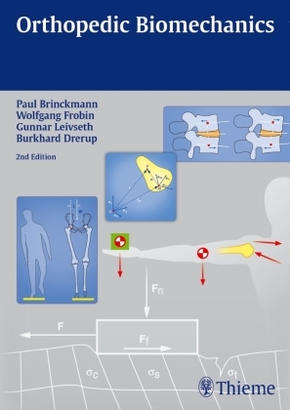Orthopedic Biomechanics
| Verlag | Thieme |
| Auflage | 2015 |
| Seiten | 496 |
| Format | 17,0 x 24,2 x 2,3 cm |
| Paperback (Thread Stitching) | |
| Gewicht | 1050 g |
| Artikeltyp | Englisches Buch |
| ISBN-10 | 3131768223 |
| EAN | 9783131768223 |
| Bestell-Nr | 13176822A |
FOUR STARS from Doody's Star Ratings
The expanded and fully updated second edition of Orthopedic Biomechanics explains the effects of mechanical influences on the musculoskeletal system and highlights the importance of biomechanical knowledge in the prevention, treatment, and rehabilitation of orthopedic injuries and disorders. Clear and concise discussion of the forces acting on bones, tendons, and ligaments facilitates a solid understanding of current and past research, complex concepts, and technical information in orthopedic biomechanics. Readers will also find practical guidance for applying their knowledge to solving actual clinical problems.
The book begins by summarizing the basic principles of biomechanics and mathematical theory, including biomaterials science, vector algebra, and movement in two and three dimensions. It then moves on to the mechanical properties of musculoskeletal tissues, with chapters devoted to muscle and muscle function; the model ing of joint loads; gait analysis; and the mechanical aspects of the hip, knee, spine, shoulder, and foot.
Key Features:
- New "Solved Problems" chapter with clinically relevant biomechanical questions and their step-by-step solutions using mathematical and mechanical reasoning
- New chapters on biomechanics of the foot and gait analysis
- Detailed descriptions of simplified model calculations for determining static and dynamic joint load-a fundamental issue in orthopedic biomechanics
- Essential physics and mathematics only, with limited use of complex vector equations
- More than 300 line illustrations
- References and suggestions for further reading at the end of each chapter, serving as an overview of scientific work on the topic
Orthopedic Biomechanics, 2nd Edition, is an essential resource for practitioners and students of orthopedics, orthopedic surgery, prosthetics and orthotics, and physi
Inhaltsverzeichnis:
Part I Mechanics: Some Basics
1 Basic Concepts from Physics and Mechanics
2 Mechanical Properties of Solid Materials
3 Deformation and Strength of Structures
Part II Mathematics: Some Basics
4 Vector Algebra
5 Matrix Notation
6 Translation and Rotation in a Plane
7 Mathematical Description of Translation and Rotation in Three-Dimensional Space
Part III Mechanical Aspects of the Human Locomotor System
8 Mechanical Properties of Bone and Cartilage
9 Structure and Function of Skeletal Muscle
10 Mechanical Aspects of Skin
11 Dimensions, Mass, Location of the Center of Mass, and Moment of Inertia of the Segments of the Human Body
12 Determination of Joint Load in a Model Calculation
13 Mechanical Aspects of the Hip Joint
14 Mechanical Aspects of the Knee Joint
15 Mechanical Aspects of the Lumbar Spine
16 Mechanical Aspects of the Shoulder
17 Biomechanics of the Foot
18 Gait
Part IV Solved Problems
19 Solved Problems< br>

